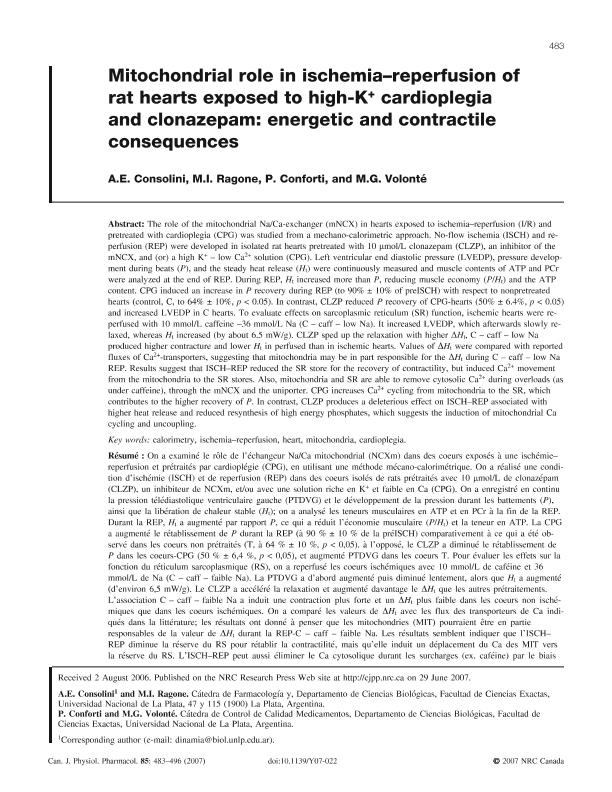Artículo
Mitochondrial role in ischemia–reperfusion of rat hearts exposed to high-K + cardioplegia and clonazepam: energetic and contractile consequences
Fecha de publicación:
05/2007
Editorial:
National Research Council Canada-NRC Research Press
Revista:
Canadian Journal Of Physiology And Pharmacology
ISSN:
0008-4212
e-ISSN:
1205-7541
Idioma:
Inglés
Tipo de recurso:
Artículo publicado
Clasificación temática:
Resumen
The role of the mitochondrial Na/Ca-exchanger (mNCX) in hearts exposed to ischemia–reperfusion (I/R) and pretreated with cardioplegia (CPG) was studied from a mechano-calorimetric approach. No-flow ischemia (ISCH) and reperfusion (REP) were developed in isolated rat hearts pretreated with 10 µmol/L clonazepam (CLZP), an inhibitor of the mNCX, and (or) a high K+ – low Ca2+ solution (CPG). Left ventricular end diastolic pressure (LVEDP), pressure development during beats (P), and the steady heat release (Ht) were continuously measured and muscle contents of ATP and PCr were analyzed at the end of REP. During REP, Ht increased more than P, reducing muscle economy (P/Ht) and the ATP content. CPG induced an increase in P recovery during REP (to 90% ± 10% of preISCH) with respect to nonpretreated hearts (control, C, to 64% ± 10%, p < 0.05). In contrast, CLZP reduced P recovery of CPG-hearts (50% ± 6.4%, p < 0.05) and increased LVEDP in C hearts. To evaluate effects on sarcoplasmic reticulum (SR) function, ischemic hearts were reperfused with 10 mmol/L caffeine –36 mmol/L Na (C – caff – low Na). It increased LVEDP, which afterwards slowly relaxed, whereas Ht increased (by about 6.5 mW/g). CLZP sped up the relaxation with higher ΔHt, C – caff – low Na produced higher contracture and lower Ht in perfused than in ischemic hearts. Values of ΔHt were compared with reported fluxes of Ca2+-transporters, suggesting that mitochondria may be in part responsible for the ΔHt during C – caff – low Na REP. Results suggest that ISCH–REP reduced the SR store for the recovery of contractility, but induced Ca2+ movement from the mitochondria to the SR stores. Also, mitochondria and SR are able to remove cytosolic Ca2+ during overloads (as under caffeine), through the mNCX and the uniporter. CPG increases Ca2+ cycling from mitochondria to the SR, which contributes to the higher recovery of P. In contrast, CLZP produces a deleterious effect on ISCH–REP associated with higher heat release and reduced resynthesis of high energy phosphates, which suggests the induction of mitochondrial Ca cycling and uncoupling.
Palabras clave:
CALORIMETRY
,
ISCHEMIA-REPERFUSION
,
HEART
,
MITOCHONDRIA
,
CARDIOPLEGIA
Archivos asociados
Licencia
Identificadores
Colecciones
Articulos(CIDCA)
Articulos de CENTRO DE INV EN CRIOTECNOLOGIA DE ALIMENTOS (I)
Articulos de CENTRO DE INV EN CRIOTECNOLOGIA DE ALIMENTOS (I)
Citación
Consolini, Alicia Elvira; Ragone, María Inés; Conforti, Paula Andrea; Volonté, Maria Guillermina; Mitochondrial role in ischemia–reperfusion of rat hearts exposed to high-K + cardioplegia and clonazepam: energetic and contractile consequences; National Research Council Canada-NRC Research Press; Canadian Journal Of Physiology And Pharmacology; 85; 5; 5-2007; 483-496
Compartir
Altmétricas




